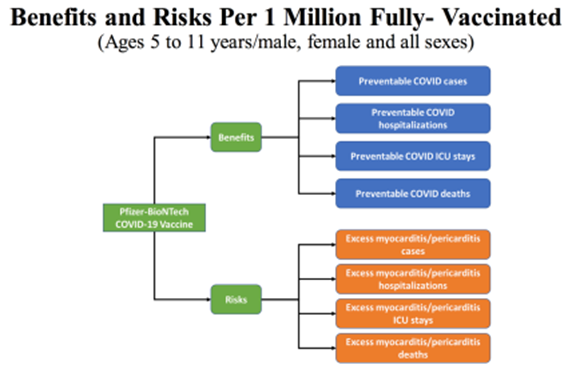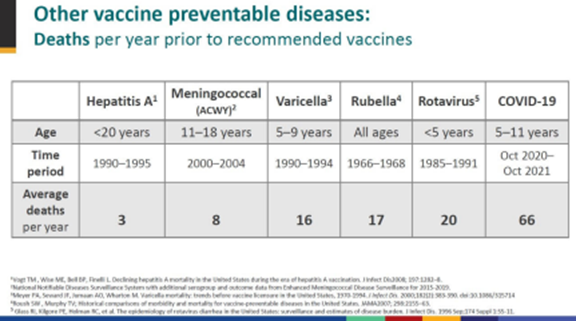Dr Musa Mohd Nordin, Dr Hung Liang Choo, Dr Amar Singh HSS, Dr Zulkifli Ismail
27 Nov 2021
This article is a follow up from our earlier article on the vaccination of children 5- 11 years old with the Pfizer vaccine. (1,2).
Since we do not have risk benefit analysis for COVID-19 vaccination in children 5-11 years old, it is best to refer to the FDA studies (3)
This was unanimously passed by the FDA panel, without opposition or abstentions. Similarly, it was evaluated by the Advisory Committee on Immunization Practices (ACIP) and unanimously recommended by all in the panel without exception.
They studied the risk benefit according to 6 different scenarios:
- Scenario 1 (Baseline COVID-19 Incidence)
- Scenario 2 (COVID-19 Peak Incidence)
- Scenario 3 (Lowest COVID-19 Incidence)
- Scenario 4 (Higher Vaccine Efficacy)
- Scenario 5 (Higher COVID-19 Death Rate)
- Scenario 6 (Lower Excess Myocarditis Rate)
Except for scenario 3, the model predicts that the benefits of the Pfizer COVID 19 vaccine given as a 2-dose primary series clearly outweigh the risks for children ages 5-11 years. (see Diagram 1 and 2)
For scenario 3 (Lowest COVID-19 Incidence), the model predicts more excess hospitalizations and ICU stays due to vaccine-related myocarditis/pericarditis compared to prevented hospitalizations and ICU stays due to COVID-19.
Notwithstanding, even under this scenario 3, considering the different
implications and length of stay for COVID-19 hospitalization (6 days) versus hospitalization for vaccine-associated myocarditis/pericarditis (1 day), and the benefits accrued from the prevention of cases of COVID-19 with significant morbidity, the overall benefits of the vaccine may still outweigh the risks.
The rates of myocarditis are based on data from adolescents and adults receiving 30ug dose of Pfizer vaccine. The dose in pediatric (5–11-year-old) age group is 1/3 i.e. 10ug dose. No cases of myocarditis occurred during the clinical trials with 5–11-year-olds.
The underlying epidemiology of viral myocarditis is substantially lower in younger children compared to children 12 years old and older. It is anticipated that the rates of myocarditis/pericarditis after vaccination in 5–11-year-old is most likely lower than the rates quoted in the risk benefit analysis
The benefit of reducing COVID related multisystem inflammatory syndrome in children (MIS-C) may not be fully captured by preventable hospitalizations, ICU stays and deaths due to COVID-19.
This risk assessment does not consider potential long-term adverse effects due to Long COVID.
This risk assessment does not include secondary benefits like reducing COVID 19 disease transmission.
It also does not include the benefits of preventing the emergence of more transmissible and virulent Variants Of Concern (VOC)
The CDC also compared the vaccination of children against other vaccine preventable diseases with the vaccination of children against COVID-19. It is obvious from Diagram 3, that we are vaccinating against vaccine preventable diseases (VPD) which have much lower mortality rates than that caused by COVID-19 in children. (4)
In summary, taking into account the 6 different scenarios, and considering the other benefits of reducing MIS-C, Long COVID, disease transmission, emergence of virulent VOC, the utilization of a much smaller dose of the vaccine, and safer return to school and social interactions, and the higher COVID-19 mortality rates versus other VPD, the benefits of the vaccine far outweighs the harm.
References:
- https://codeblue.galencentre.org/2021/11/25/covid-19-can-we-afford to-delay-vaccinating-children-aged-5-11-dr-amar-singh-hss-dr-hung liang-choo-dr-musa-mohd-nordin-dr-zulkifli-ismail/
- https://www.malaysiakini.com/columns/600694
- https://www.cdc.gov/vaccines/acip/meetings/downloads/slides-2021-11- 2-3/08-COVID-Oliver-508.pdf
- https://www.cdc.gov/vaccines/acip/meetings/downloads/slides-2021-11- 2-3/08-COVID-Oliver-508.pdf
Diagram 1:

Diagram 2:

Diagram 3:



